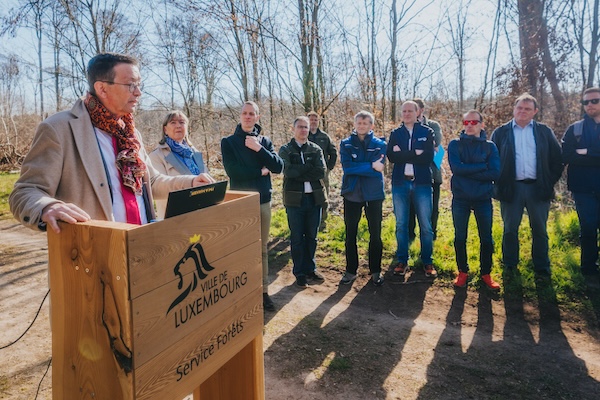 Credit: © Ville de Luxembourg - Fränk Schneider
Credit: © Ville de Luxembourg - Fränk Schneider
On Thursday 3 April 2025, the City of Luxembourg (VdL), together with the Ministry of the Environment, Climate and Biodiversity, the Nature and Forest Agency and the Luxembourg Institute of Science and Technology (LIST), presented the research project "FORLUX - Health, Adaptation and Resilience of the Forests of Luxembourg City".
The authorities reported that the multi-year project, launched at a research site in the Bambësch forest and funded by the ministry through the Climate and Energy Fund, "sets up experimental plots to observe and measure how local forests respond over time to changing weather patterns with the aim to pave the way for new strategies in forest management."
Those involved in the project described how Luxembourg's forests, mostly made up of beech and oak trees, face increasing threats from climate change, with nearly 60% of beech trees already showing signs of damage from drought. They noted that "with projections indicating longer, more frequent and intense dry spells, the City of Luxembourg has stepped up its environmental effort" and has "created a roadmap based on five key priorities and launched concrete projects to protect and conserve forested areas, recognising their vital role in tackling climate change."
According to the authorities, Luxembourg City's forests cover 1,055 hectares - aprroximately 20% of its total area - and help safeguard water quality from the Luxembourg sandstone springs, which feed the city's drinking water supply. They also buffer climate warming through natural cooling and air humidification, filter air pollutants, sequester carbon, support biodiversity and provide valuable recreational space for residents.
To improve how forests are managed in a changing climate, the authorities noted that they must first understand how trees react to changes in water availability, carbon cycles and nutrients. To achieve this, the project has established observatories in several representative areas of forest. These sites will use sensors to gather data on tree health (including water stress and disease), weather, air quality, water infiltration and carbon storage in both trees and soil. Researchers will then use this information to build a modelling tool that can simulate forest development under various climate and forest management scenarios.
The FORLUX project brings together LIST researchers, forest managers (from both the VdL and the Nature and Forest Agency) and local citizens and focuses on three main goals:
- to assess and anticipate how forests respond to climate change;
- to develop strategies to adapt forest management practices;
- to raise public awareness and involve residents in forest protection efforts.
The authorities reported that the first fully operational observation station has been running since July 2022 on the Bambësch plateau and marks the starting point for several research projects designed to expand knowledge and identify practical solutions across various key areas.
In relation to climate resilience, researchers are using long-term observation protocols - focusing on soil, roots, trunks and canopies - to study how different native and non-native tree species cope with climate change. This is intended to help identify the pressures forests may face and guide forest managers in adapting their methods.
For the protection of groundwater resources, the authorities described how forest ecosystems play a key role in protecting water resources vital for drinking water. By monitoring local weather, soil moisture and spring flow rates, scientists aim to understand the water balance in communal forests and predict how future droughts might affect groundwater.
Regarding the interactions between forest and urban areas, the authorities noted that forests help cool urban areas during heatwaves and improve nearby air quality. However, nearby urban development can disrupt forest ecosystems through heat retention from buildings and roads, limited airflow and increased pollution. Understanding these interactions can help strike a balance between urban growth and ecological preservation.
In terms of public engagement and awareness, the project will adopt a "citizen science" approach, with the City of Luxembourg, LIST and the Nature and Forest Agency encouraging residents to actively contribute to scientific data collection. This will also help raise awareness of the many ecosystem benefits forests can provide.
For gathering early results and remote sensing, data from the first experimental station has already helped to refine remote sensing techniques that map how drought stress varies across the Bambësch forest. According to the authorities, combining on-site measurements with regional satellite imagery will provide valuable insights for adapting forest management to future climate disturbances.
The authorities acknowledged that the effects of climate change are increasingly affecting Luxembourg's society, health and ecosystems. To meet these growing challenges, the national climate adaptation strategy outlines a wide range of actions to reduce negative impacts. The authorities also emphasised that the FORLUX project shows how government, local authorities and research institutions can work together to strengthen resilience and protect forests, adding that, as climate change affects every part of society, it is crucial to take action across all policy areas.
The current draft of the national adaptation strategy - which includes 131 concrete measures - is now open for public consultation. Five public workshops will take place in April and May 2025, offering everyone the opportunity to help shape and implement these actions.
Further information relating to the draft strategy and action plan for adapting to the effects of climate change in Luxembourg can be found at: https://www.zesumme-vereinfachen.lu/en-GB/projects/klimaadaptatiounsstrategie
SM








